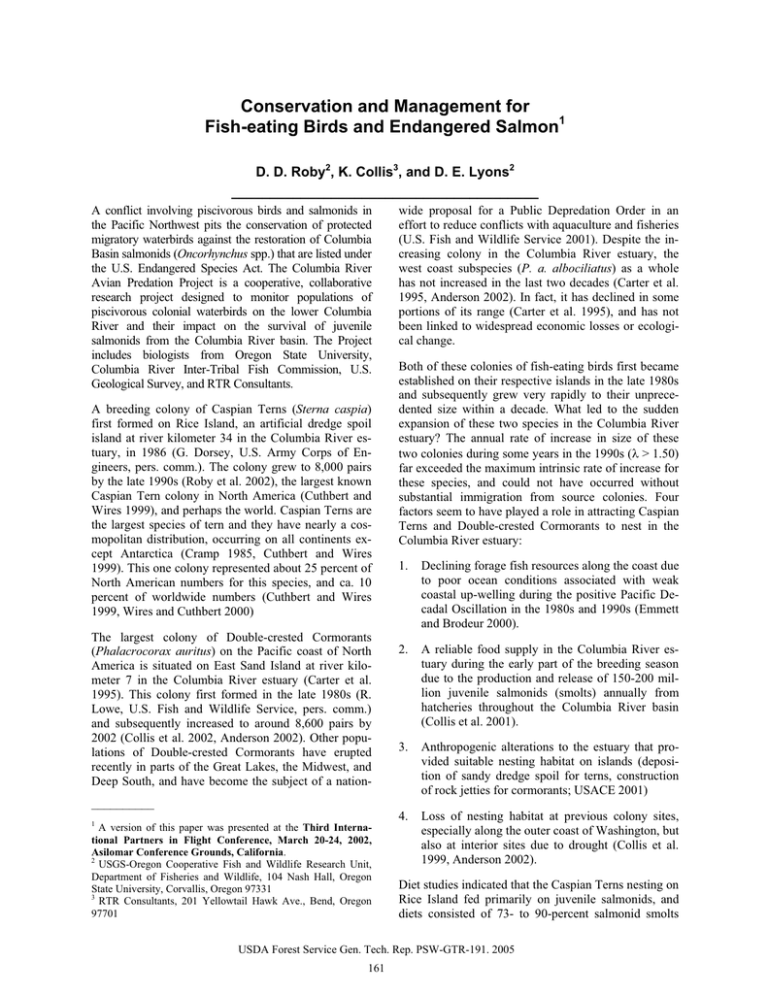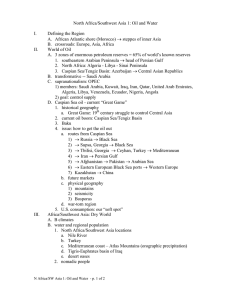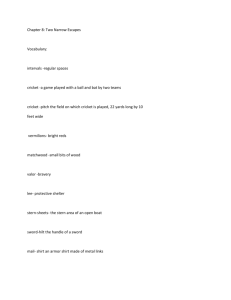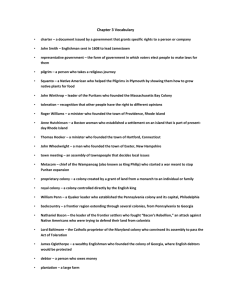Conservation and Management for Fish-eating Birds and Endangered Salmon D. D. Roby
advertisement

Conservation and Management for Fish-eating Birds and Endangered Salmon1 D. D. Roby2, K. Collis3, and D. E. Lyons2 ________________________________________ A conflict involving piscivorous birds and salmonids in the Pacific Northwest pits the conservation of protected migratory waterbirds against the restoration of Columbia Basin salmonids (Oncorhynchus spp.) that are listed under the U.S. Endangered Species Act. The Columbia River Avian Predation Project is a cooperative, collaborative research project designed to monitor populations of piscivorous colonial waterbirds on the lower Columbia River and their impact on the survival of juvenile salmonids from the Columbia River basin. The Project includes biologists from Oregon State University, Columbia River Inter-Tribal Fish Commission, U.S. Geological Survey, and RTR Consultants. A breeding colony of Caspian Terns (Sterna caspia) first formed on Rice Island, an artificial dredge spoil island at river kilometer 34 in the Columbia River estuary, in 1986 (G. Dorsey, U.S. Army Corps of Engineers, pers. comm.). The colony grew to 8,000 pairs by the late 1990s (Roby et al. 2002), the largest known Caspian Tern colony in North America (Cuthbert and Wires 1999), and perhaps the world. Caspian Terns are the largest species of tern and they have nearly a cosmopolitan distribution, occurring on all continents except Antarctica (Cramp 1985, Cuthbert and Wires 1999). This one colony represented about 25 percent of North American numbers for this species, and ca. 10 percent of worldwide numbers (Cuthbert and Wires 1999, Wires and Cuthbert 2000) The largest colony of Double-crested Cormorants (Phalacrocorax auritus) on the Pacific coast of North America is situated on East Sand Island at river kilometer 7 in the Columbia River estuary (Carter et al. 1995). This colony first formed in the late 1980s (R. Lowe, U.S. Fish and Wildlife Service, pers. comm.) and subsequently increased to around 8,600 pairs by 2002 (Collis et al. 2002, Anderson 2002). Other populations of Double-crested Cormorants have erupted recently in parts of the Great Lakes, the Midwest, and Deep South, and have become the subject of a nation- wide proposal for a Public Depredation Order in an effort to reduce conflicts with aquaculture and fisheries (U.S. Fish and Wildlife Service 2001). Despite the increasing colony in the Columbia River estuary, the west coast subspecies (P. a. albociliatus) as a whole has not increased in the last two decades (Carter et al. 1995, Anderson 2002). In fact, it has declined in some portions of its range (Carter et al. 1995), and has not been linked to widespread economic losses or ecological change. Both of these colonies of fish-eating birds first became established on their respective islands in the late 1980s and subsequently grew very rapidly to their unprecedented size within a decade. What led to the sudden expansion of these two species in the Columbia River estuary? The annual rate of increase in size of these two colonies during some years in the 1990s (O> 1.50) far exceeded the maximum intrinsic rate of increase for these species, and could not have occurred without substantial immigration from source colonies. Four factors seem to have played a role in attracting Caspian Terns and Double-crested Cormorants to nest in the Columbia River estuary: 1. Declining forage fish resources along the coast due to poor ocean conditions associated with weak coastal up-welling during the positive Pacific Decadal Oscillation in the 1980s and 1990s (Emmett and Brodeur 2000). 2. A reliable food supply in the Columbia River estuary during the early part of the breeding season due to the production and release of 150-200 million juvenile salmonids (smolts) annually from hatcheries throughout the Columbia River basin (Collis et al. 2001). 3. Anthropogenic alterations to the estuary that provided suitable nesting habitat on islands (deposition of sandy dredge spoil for terns, construction of rock jetties for cormorants; USACE 2001) 4. Loss of nesting habitat at previous colony sites, especially along the outer coast of Washington, but also at interior sites due to drought (Collis et al. 1999, Anderson 2002). __________ 1 A version of this paper was presented at the Third International Partners in Flight Conference, March 20-24, 2002, Asilomar Conference Grounds, California. 2 USGS-Oregon Cooperative Fish and Wildlife Research Unit, Department of Fisheries and Wildlife, 104 Nash Hall, Oregon State University, Corvallis, Oregon 97331 3 RTR Consultants, 201 Yellowtail Hawk Ave., Bend, Oregon 97701 Diet studies indicated that the Caspian Terns nesting on Rice Island fed primarily on juvenile salmonids, and diets consisted of 73- to 90-percent salmonid smolts USDA Forest Service Gen. Tech. Rep. PSW-GTR-191. 2005 161 Conservation and Management for Birds and Salmon—Roby, Collis, and Lyons colony on Rice Island is not a reflection of unsuitable nesting conditions (i.e., too many nest predators or inadequate food supply) on East Sand Island. during 1997-2000 (Roby et al. 2002). Bioenergetics modeling indicated that terns were consuming approximately 11 to 12 million smolts annually, or about 10 to 12 percent of all the young salmon that reached the estuary each year (CBR 2002). Young salmon were not as prevalent in the diet of Double-crested Cormorants nesting on East Sand Island (Collis et al. 2002), but cormorants still consumed about 4 - 6 million smolts annually, or roughly 4 to 6 percent of all young salmon that reached the estuary each year (D. E. Lyons, unpubl. data). 3. The Working Group restored tern nesting habitat on East Sand Island and used social attraction techniques (decoys and playback systems; see Kress 1983) and selective gull removal to attract terns to nest on East Sand Island (Roby et al. 2002). Concurrently, they erected silt fencing and plastic streamers on parts of the Rice Island colony site to help dissuade terns from nesting there (Roby et al. 2002). Within three breeding seasons the Rice Island tern colony had completely relocated to East Sand Island (fig. 1a); no destruction of tern eggs or young was involved. About 9,000 pairs of Caspian Terns nested on East Sand Island in 2001, the largest Caspian Tern colony ever recorded (Roby et. al 2002). Nesting success of Caspian Terns at the East Sand Island colony has been consistently higher than at Rice Island; in 2001 nearly 12,000 young Caspian Terns were raised at East Sand Island (Roby et al. 2002). This might have passed as a predator nuisance issue for the salmon hatcheries because most of the juvenile salmonids consumed were of hatchery origin (Collis et al. 2001). However, most of the wild runs of salmon from the Columbia River Basin, which were also consumed by piscivorous waterbirds (Collis et al. 2001), are listed as threatened or endangered under the Endangered Species Act (ESA). Twelve of 20 evolutionarily significant units (ESUs) of salmon from the Columbia Basin are listed (NMFS 2002a), and some are so imperiled that they are predicted to go extinct within 1020 years (NMFS 2002b). Recovery of passive integrated transponder (PIT) tags from young salmon on the Rice Island Caspian Tern and Double-crested Cormorant colonies indicated that threatened or endangered salmonids were taken by these birds in proportion to their availability (Collis et al. 2001). Breeding Pairs Rice Island The Rice Island tern colony can be relocated to East Sand Island using habitat manipulation at both sites and social attraction techniques at East Sand Island. 2. A relocated colony of Caspian Terns on East Sand Island would experience similar nesting success to that of the Rice Island colony; the presence of the East Sand Island 10000 8000 6000 4000 2000 0 Millions of Smolts Consumed. While avian predators in the lower Columbia River were not the cause of the dramatic declines in Columbia Basin salmonids, National Marine Fisheries Service, which has management responsibility for anadromous fish and recovery responsibility for listed salmonids in the Columbia Basin, concluded that predation by Caspian Terns in the estuary hinders recovery of listed Columbia Basin salmonids (NMFS 2000c). The Interagency Caspian Tern Working Group was formed in 1998, with representation from the federal, state, and tribal agencies with management authority and responsibility for terns, salmon, and the lands they use. The magnitude of predation on juvenile salmonids by Rice Island terns led to an attempt by the Interagency Caspian Tern Working Group to relocate the colony to East Sand Island, 26 km closer to the ocean, where it was hoped terns would consume fewer salmonids. The Working Group devised a pilot study to test three relevant hypotheses: 1. A colony of Caspian Terns on East Sand Island will consume a greater diversity of forage fishes, including many marine species, and significantly fewer juvenile salmonids. 1997 1998 1999 2000 2001 1997 1998 1999 2000 2001 12 9 6 3 0 Figure 1— Size of Caspian Tern breeding colonies (number of breeding pairs) on two islands in the Columbia River estuary during 1997-2001 (a), and estimated numbers of juvenile salmonids (in millions of smolts) consumed by all Caspian Terns nesting in the Columbia River estuary during 1997-2001, based on bioenergetics models (b). Caspian Tern diets shifted from primarily juvenile salmonids at Rice Island to mostly marine forage fishes, such as northern anchovy (Engraulis mordax), surfperches (Embiotocidae), Pacific herring (Clupea pallasi), Pacific sardine (Sardinops sagax), and smelts (Osmeridae), at East Sand Island (Roby et al. 2002). The estimated 5.9 million salmonid smolts consumed by terns in 2001 represented a 50 percent reduction in salmonid smolt mortality due to tern predation compared to 1999 (fig. 1b; CBR 2002). To achieve further USDA Forest Service Gen. Tech. Rep. PSW-GTR-191. 2005 162 Conservation and Management for Birds and Salmon—Roby, Collis, and Lyons reductions in consumption of ESA-listed juvenile salmonids by Caspian Terns in the Columbia River estuary, it may be necessary to relocate a portion of the East Sand Island colony to alternative sites. In addition to being the largest Caspian Tern colony in the world, the East Sand Island colony is currently the only documented Caspian Tern colony on the outer coast of the Pacific Northwest (fig. 2). (A small colony consisting of 100 to 300 pairs was found on the roof of a warehouse in the Port of Tacoma, south Puget Sound in June 2002, but the terns will not be permitted to nest there again in 2003 [M. Tirhi, Washington Department of Fish and Wildlife, pers. comm.].) The colony on East Sand Island represents about two-thirds of all breeding adults in the Pacific coast population of the species (fig. 2; Cuthbert and Wires 1999, Wires and Cuthbert 2000). The large concentration of breeding pairs at one site is not typical for this species, and renders it more vulnerable to local catastrophes (e.g., storms, oil spills, disease outbreaks, and disturbance). Eight other locations along the coast of the Pacific Northwest were formerly used as colony sites by Caspian Terns but were abandoned due to island erosion, human development, or other factors (Collis et al. 1999). Restoration of tern colony sites outside the Columbia River estuary and along the coast of the Pacific Northwest has the potential to benefit both Columbia Basin salmonids and Pacific coast Caspian Terns. and their breeding colonies could mitigate for the impact of dams on salmonids. Others have advocated that all dams be breached before implementation of any management to reduce avian predation on Columbia Basin salmonids. Finding solutions to issues involving avian predators and ESA-listed prey will require sound peer-reviewed science, new interagency partnerships, innovative management approaches, and outreach to stakeholders. The U.S. Fish and Wildlife Service is leading the effort to develop a long-term plan for Caspian Tern management and conservation on the west coast. This will include identifying potential colony restoration sites outside the Columbia River estuary. East Sand Island will presumably remain one of the larger Caspian Tern colonies on the west coast, but perhaps not the largest colony of this species in the world. In addition to management of Caspian Tern breeding habitat, other activities have been undertaken in the region to reduce avian predation on juvenile salmonids. Passive measures (e.g., wires, excluders, etc.) have been used to dissuade birds at foraging locations such as mainstem hydroelectric dams (Jones et al. 1996) and pile dikes (USACE 2001), where juvenile salmonids may be particularly vulnerable to avian predators. Efforts to reduce avian predation have been only one part, however, of the region’s larger struggle to find effective strategies for recovering salmon that have broad support from managers and disparate publics (Lichatowich 1999, NMFS 2000c). Consensus on avian predation has not always been easy to reach, even among the federal, state, and tribal agencies that make up the Interagency Caspian Tern Working Group. Similarly, various publics and some of the press have attempted to portray the issue as a conflict between Caspian Terns and hydroelectric dams (e.g., Fialka 2000). Some have argued that destroying terns Figure 2— Distribution and size of known Caspian Tern breeding colonies for the Pacific coast population in North America as of the year 2000. Acknowledgments The following individuals provided invaluable assistance in the field: S. Adamany, J. Adkins, C. D. Anderson, S. K. USDA Forest Service Gen. Tech. Rep. PSW-GTR-191. 2005 163 Conservation and Management for Birds and Salmon—Roby, Collis, and Lyons the lower Columbia River. 1998. Annual report of the Oregon Cooperative Fish and Wildlife Unit, Oregon State University to Bonneville Power Administration and U.S. Army Corps of Engineers, Portland, Oregon. Anderson, M. Antolos, N. Bargmann, B. Begay, K. Brakensiek, E. Bridge, C. Cardoni, N. Chelgren, H. Christy, C. Couch, C. Cowan, D. M. Craig, D. P. Craig, B. Davis, G. Dorsey, C. Faustino, K. Fischer, K. Gorman, R. Kerney, P. J. Klavon, M. Layes, S. Lehmann, L. Leonard, T. Lewis, C. Lindsey, D. Lynch, S. McDougal, A. Meckstroth, D. Moskowitz, A. M. Myers, K. Redman, B. Robertson, D. Robinson, I. Rose, J. Rosier, L. Sheffield, N. Spang, C. Spiering, P. Spiering, R. Suryan, M. Thompson, R. Westra, M. Williams, J. Wolf, and S. Wright. We are grateful for the assistance of the following individuals: R. Anthony, R. Beach, R. Beaty, P. Bentley, B. Bergman, G. Bisbal, B. Bortner, C. Brown, C. Bruce, H. Blokpoel, J. Cyrus, F. Dobler, G. Dorsey, S. Duncan, M. Hawbecker, G. Henning, J. Henry, C. Henson, J. Hill, E. Holsberry, S. Kress, B. Lakey, D. Ledgerwood, N. Maine, D. Markle, K. Martinson, W. Maslen, R. Maziaka, B. Meyer, H. Michael, M. Morin, D. Mostajo, M. Naughton, H. Pollard, R. Ronald, T. Ruszkowski, B. Ryan, K. Salarzon, C. Schreck, S. Schubel, C. Schuler, N. Seto, T. Stahl, E. Stone, T. Tate-Hall, C. Thompson, L. Todd, K. Turco, D. Vandebergh, D. Ward, M. Weiss, D. Wesley, M. Wilhelm, R. Willis, and T. Zimmerman. This research project benefited enormously from the collaboration and cooperation of the Columbia River Inter-Tribal Fish Commission, U.S. Fish and Wildlife Service, U.S. Army Corps of Engineers, National Marine Fisheries Service, Oregon Department of Fish and Wildlife, Washington Department of Fish and Wildlife, and Idaho Department of Fish and Game. This project was funded by the Northwest Power Planning Council, the Bonneville Power Administration, and the U.S. Army Corps of Engineers. R. Altman, M. Naughton, and T. Rich provided helpful comments that improved an earlier draft of this paper. Collis, K., D. D. Roby, D. P. Craig, B. A. Ryan, R. D. Ledgerwood. 2001. Colonial waterbird predation on juvenile salmonids tagged with passive integrated transponders in the Columbia River estuary: Vulnerability of different salmonid species, stocks, and rearing types. Transactions of the American Fisheries Society 130: 385-396. Collis, K., D. D. Roby, D. P. Craig, S. L. Adamany, J. Y. Adkins, and D. E. Lyons. 2002. Colony size and diet composition of piscivorous waterbirds on the lower Columbia River: Implications for losses of juvenile salmonids to avian predators. Transactions of the American Fisheries Society 131: 537-550. Cramp, S., editor. 1985. Handbook of the birds of Europe, the Middle East and North Africa: The birds of the western Palearctic, Vol. 4. New York: Oxford University Press. Cuthbert, F. J. and L. R. Wires. 1999. Caspian tern (Sterna caspia). In: A. Poole and F. Gill, editors. The birds of North America, no. 403. Philadelphia, PA: The Birds of North America, Inc. Emmett, R. L. and R. D. Brodeur. 2000. Recent changes in the pelagic nekton community off Oregon and Washington in relation to some physical oceanographic conditions. North Pacific Anadromous Fishery Commission Bulletin Number 2: 11-20. Fialka, J. J. 2000. Terns join dams as salmon’s foe, but don’t tell the Gore camp. Wall Street Journal, August 11, 2000. Jones, S. T., G. M. Starke, and R. J. Stansell. 1996. Predation by birds and effectiveness of predation control measures at Bonneville, The Dalles, and John Day dams in 1995. CENPP-CO-SRF. Operations Division, Portland District, U.S. Army Corps of Engineers; 10 p. Kress, S. W. 1983. The use of decoys, sound recordings, and gull control for re-establishing a tern colony in Maine. Colonial Waterbirds 6: 185-196. Literature Cited Anderson, C. D. 2002. Factors affecting colony size, reproductive success, and foraging patterns of Double-crested Cormorants nesting on East Sand Island in the Columbia River estuary. Corvallis, OR: Oregon State University. Unpublished M.Sc. thesis. Lichatowich, J. 1999. Salmon without rivers: A history of the Pacific salmon crisis. Washington DC: Island Press; 317 p. National Marine Fisheries Service (NMFS). 2002a. Endangered Species Act status of west coast salmonids, December 26, 2001. Portland, OR: Northwest Region, National Marine Fisheries Service, U.S. Department of the Interior. Available through the Internet at http://www.nwr.noaa.gov (accessed 19 June 2002). Carter, H. R., A. L. Sowls, M. S. Rodway, U. W. Wilson, R. W. Lowe, G. J. McChesney, F. Gress, and D. W. Anderson. 1995. Population size, trends, and conservation problems of the double-crested cormorant on the Pacific coast of North America. In: D. N. Nettleship and D. C Duffy, editors. The Double-crested Cormorant: Biology, conservation and management. Colonial Waterbirds 18 (Special Publication 1): 189-215. National Marine Fisheries Service (NMFS). 2002b. Cumulative risk initiative intranet. Portland, OR: Northwest Region, National Marine Fisheries Service. Available through the Internet at http://www.nwfsc.noaa.gov/cri (accessed 19 June 2002). Columbia Bird Research (CBR). 2002. Caspian Tern Research on the Lower Columbia River: 2001 Draft Season Summary. Bend, OR: Real Time Research. Available at http://www.columbiabirdresearch.org (accessed 19 June 2002). National Marine Fisheries Service (NMFS). 2002c. Biological opinion for reinitiation of consultation on operation of the Federal Columbia River power system. Portland, OR: Northwest Region, National Marine Fisheries Service. Collis, K., S. L. Adamany, D. D. Roby, D. P. Craig, and D. E. Lyons. 1999. Avian predation on juvenile salmonids in USDA Forest Service Gen. Tech. Rep. PSW-GTR-191. 2005 164 Conservation and Management for Birds and Salmon—Roby, Collis, and Lyons Roby, D. D., K. Collis, D. E. Lyons, D. P. Craig, J. Y. Adkins, A. M. Myers, and R. M. Suryan. 2002. Effects of colony relocation on diet and productivity of Caspian terns. Journal of Wildlife Management 66: 662-673. United States Army Corps of Engineers (USACE). 2001. Caspian tern relocation FY 2001-2002 management plan and pile dike modification to discourage cormorant use, lower Columbia River, Oregon and Washington. Environmental Assessment and Finding of No Significant Im- pact. Portland, OR: Portland District, U.S. Army Corps of Engineers. United States Fish and Wildlife Service (USFWS). 2001. Draft environmental impact statement: Double-crested cormorant management. Portland, OR: Division of Migratory Bird Management, U.S. Fish and Wildlife Service; 113 p. Wires, L. R. and F. J. Cuthbert. 2000. Trends in Caspian tern numbers and distribution in North America: A review. Waterbirds 23: 388-404. USDA Forest Service Gen. Tech. Rep. PSW-GTR-191. 2005 165








